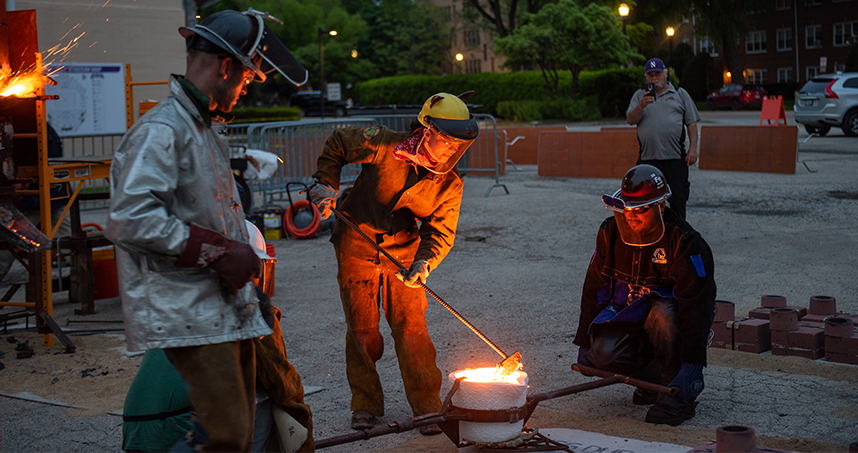Inspired by Leonardo da Vinci, Design Class Explores Geometry, Manufacturing, and Art
Interdisciplinary class introduced students to experiences from an iron pour to creating pieces for an art exhibit
Watching sparks fly and 600 pounds of melting iron glow from a historical furnace set in the parking lot of Ryan Field, Mike Pitorak was excited, fulfilling his year-long plan to take DSGN 395-64: Leonardo, Geometry, and the Art of Manufacturing before graduation.
This spring quarter, the Northwestern Engineering recent graduate did just that.
“The iron pour is going to be one of the highlights of my time at Northwestern that I’ll always look back on,” said Pitorak (’19), who double majored in Manufacturing and Design Engineering (MaDE) and mechanical engineering. “The event gave me the chance to not only use my knowledge of manufacturing processes I’ve gained through the MaDE program, but also to express artistic creativity and contribute to a really fun, cool event.”
Held in the evening, the iron pour is the culminating activity in the interdisciplinary Segal Design Institute course centered around studying design and manufacturing through the lens of geometry, a passion of Renaissance man Leonardo da Vinci. The class is open to both students in the McCormick School of Engineering and other schools at Northwestern.
The course is taught by Matthew Cummins, adjunct lecturer in the Segal Design Institute, and David Gatchell, Charles Deering McCormick Distinguished Clinical Professor of Biomedical Engineering and Mechanical Engineering. Gatchell also is director of MaDE, a one-of-a-kind program focused on product design and realization, along with manufacturing technologies, taught through classes across engineering disciplines including industrial and mechanical engineering, as well as design.
Gatchell and Cummins built on the class’s first run last year by creating more opportunities for hands-on learning experiences involving artistic and industrial processes.
 “The primary goal was to give the students an experience they’d never forget,” Cummins said.
“The primary goal was to give the students an experience they’d never forget,” Cummins said.
One project involved learning about the five Platonic solids, geometric shapes of which philosopher Plato believed the classical elements were made. Students were tasked to create a dodecahedron, a geometric figure consisting of 12 pentagonal faces, out of any materials they wanted.
Some students used pipe cleaners, origami, or 3D printers. One created an ice mold, while another welded steel plates together in the geometric shape.
“In the engineering school, we spend a lot of time solving math problems, solving engineering problems, looking in the back of the book, understanding the theory,” Gatchell said. “When you get your hands on something, you start realizing, wow, there’s so much learning that could take place here.”
A new component of the class involved creating pieces for an art exhibit on display in the Evanston Art Center for two weeks during spring quarter focused on representing Platonic solids and Archimedean solids.
Peter Hosbein (’19), a recent graduate who earned a materials science and engineering degree with a Segal Design Certificate, creates ceramic art in his spare time. He paired up with MaDE senior Sam Shealy, who is a painter, to use their artistic talents to create two of the five Platonic solids, a dodecahedron and an icosahedron, for the exhibit.
“The class has been pretty life changing,” Hosbein said. “I appreciate the underlying math and art concepts that this class has shown me about the world. It’s also been fun to collaborate across disciplines.”
 That collaboration enriches the class. “The two instructors aren’t the only teachers. Students are always teaching students,” Gatchell said. “Students are sharing with other students these fabrication processes and opening up new worlds for each other.”
That collaboration enriches the class. “The two instructors aren’t the only teachers. Students are always teaching students,” Gatchell said. “Students are sharing with other students these fabrication processes and opening up new worlds for each other.”
This year’s class included a trip off campus to the largest integrated steel facility in North America. Students traveled just 20 miles southeast of Chicago’s skyscrapers to East Chicago, Indiana, where they were surrounded by smokestacks and railroad tracks. More than 100 years old and home to three blast furnaces, ArcelorMittal's Indiana Harbor Complex has the capability to produce approximately 6.2 million tons of steel annually.
“Walking through a facility like that provided a teachable moment that none of them could get in the classroom,” Cummins said.
Other class activities tapped into a range of students’ skills from advanced welding and using computer-aided design to using a compass and straight edge to create basic geometric shapes – all ways of exploring manufacturing and design through geometry.
“Geometry is an underpinning if you want to study science. Geometry is a pretty good place to start if you want to study art, or if you’re interested in architecture and creativity,” Cummins said. “Fundamental geometry is a universal language that spans across cultures. Once you’re aware of it, you see it everywhere, and you recognize the interconnectedness of things.”




